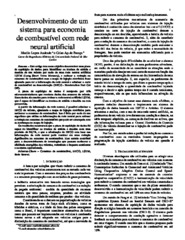Mostrar el registro sencillo del ítem
Desenvolvimento de um sistema para economia de combustível com rede neural artificial
| dc.contributor.author | Andrade, Murilo Lopes | |
| dc.date.accessioned | 2023-04-11T15:16:12Z | |
| dc.date.available | 2023-04-11T15:16:12Z | |
| dc.date.issued | 2023-04-06 | |
| dc.identifier.citation | ANDRADE, Murilo Lopes. Desenvolvimento de um sistema para economia de combustível com rede neural artificial. 2023. Trabalho de Conclusão de Curso (Graduação em Engenharia Elétrica) – Universidade Federal de São Carlos, São Carlos, 2023. Disponível em: https://repositorio.ufscar.br/handle/ufscar/17681. | * |
| dc.identifier.uri | https://repositorio.ufscar.br/handle/ufscar/17681 | |
| dc.description.abstract | This article aims to develop a data acquisition board to identify the uphill and downhill stretches of a vehicle through an LSTM (Long Short Term Memory) artificial neural network, and to estimate the reduction in fuel consumption if the electronic injection was adjusted to take the information from the neural network and optimize the fuel cut on deceleration (DFCO - Deceleration Fuel Cut Off). The data acquisition board is composed of three microcontrollers that receive data from the vehicle's sensors. This data is used to train the LSTM artificial neural network, which is able to identify the uphill and downhill stretches in the route taken. From the neural network information, it is possible to optimize the vehicle's DFCO, adjusting the electronic injection map to improve fuel consumption. This is done through an algorithm that uses information from the neural network to estimate the reduction in fuel consumption that can be achieved with changes in the injection map. The results showed that the data acquisition board was able to identify the uphill and downhill stretches with an accuracy of 96.7%, and that the optimization of the DFCO based on the neural network information can result in a significant reduction in consumption. of fuel. This study contributes to the development of technologies that can improve the energy efficiency of vehicles, reducing environmental impact and operating costs. | eng |
| dc.description.sponsorship | Não recebi financiamento | por |
| dc.language.iso | por | por |
| dc.publisher | Universidade Federal de São Carlos | por |
| dc.rights | Attribution 3.0 Brazil | * |
| dc.rights.uri | http://creativecommons.org/licenses/by/3.0/br/ | * |
| dc.subject | Consumo de Combustível | por |
| dc.subject | Fuel Consumption | por |
| dc.subject | DFCO | por |
| dc.subject | LSTM | por |
| dc.subject | Rede Neural | por |
| dc.subject | Neural Network | por |
| dc.title | Desenvolvimento de um sistema para economia de combustível com rede neural artificial | por |
| dc.title.alternative | Development of a system for fuel economy with artificial neural network | eng |
| dc.type | TCC | por |
| dc.contributor.advisor1 | França, Celso Aparecido de | |
| dc.contributor.advisor1Lattes | http://lattes.cnpq.br/4547836128892982 | por |
| dc.description.resumo | Este artigo tem como objetivo desenvolver uma placa de aquisição de dados para identificar os trechos de subida e descida de um veículo por meio de uma rede neural artificial LSTM (Long Short Term Memory), e estimar a redução no consumo de combustível caso o mapa de injeção eletrônica fosse ajustado para ter a informação da rede neural e otimizar o corte de combustível na desaceleração (DFCO - Deceleration Fuel Cut Off). A placa de aquisição de dados é composta por três microcontroladores que recebem dados dos sensores do veículo. Esses dados são usados para treinar a rede neural artificial LSTM, que é capaz de identificar os trechos de subida e descida na rota percorrida. A partir da informação da rede neural, é possível otimizar o DFCO do veículo, ajustando o mapa de injeção eletrônica para melhorar o consumo de combustível. Isso é feito por meio de um algoritmo que utiliza as informações da rede neural para estimar a redução no consumo de combustível que pode ser alcançada com as mudanças no mapa de injeção. Os resultados mostraram que a placa de aquisição de dados foi capaz de identificar os trechos de subida e descida com uma precisão de 96,7%, e que a otimização do DFCO com base nas informações da rede neural pode resultar em uma redução significativa no consumo de combustível. Esse estudo contribui para o desenvolvimento de tecnologias que possam melhorar a eficiência energética dos veículos, reduzindo o impacto ambiental e os custos operacionais. | por |
| dc.publisher.initials | UFSCar | por |
| dc.subject.cnpq | CIENCIAS EXATAS E DA TERRA::CIENCIA DA COMPUTACAO::METODOLOGIA E TECNICAS DA COMPUTACAO | por |
| dc.subject.cnpq | ENGENHARIAS::ENGENHARIA ELETRICA::CIRCUITOS ELETRICOS, MAGNETICOS E ELETRONICOS::CIRCUITOS ELETRONICOS | por |
| dc.subject.cnpq | ENGENHARIAS::ENGENHARIA ELETRICA::CIRCUITOS ELETRICOS, MAGNETICOS E ELETRONICOS | por |
| dc.publisher.address | Câmpus São Carlos | por |
| dc.contributor.authorlattes | http://lattes.cnpq.br/4803439978090374 | por |
| dc.publisher.course | Engenharia Elétrica - EE | por |

